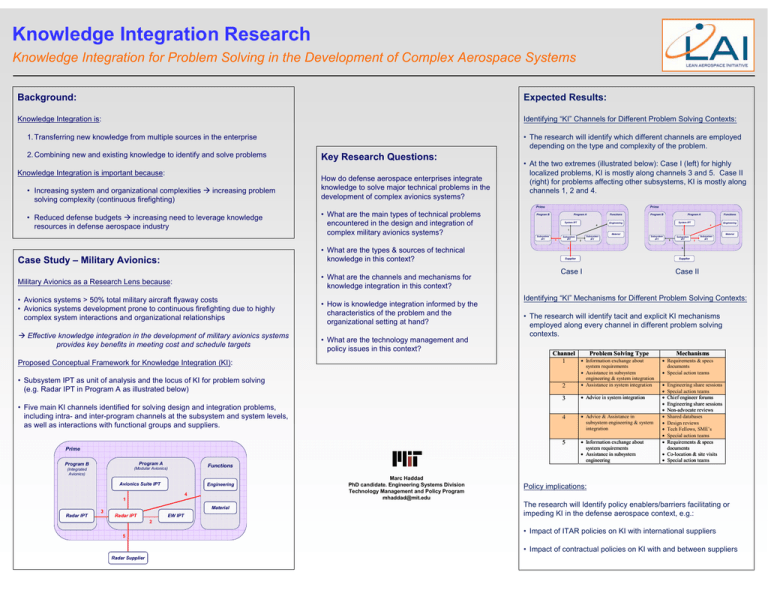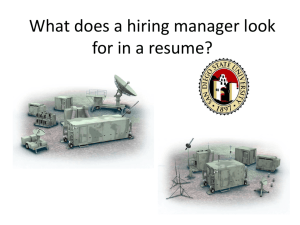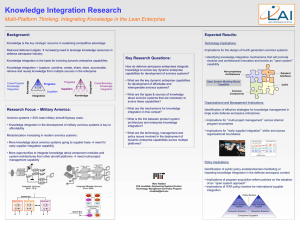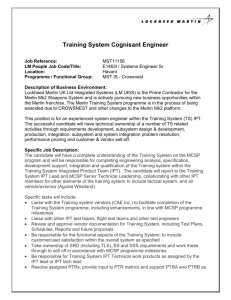Knowledge Integration Research Background: Expected Results:
advertisement

Knowledge Integration Research Knowledge Integration for Problem Solving in the Development of Complex Aerospace Systems Background: Expected Results: Knowledge Integration is: Identifying “KI” Channels for Different Problem Solving Contexts: 1. Transferring new knowledge from multiple sources in the enterprise 2. Combining new and existing knowledge to identify and solve problems Knowledge Integration is important because: • Increasing system and organizational complexities Æ increasing problem solving complexity (continuous firefighting) • The research will identify which different channels are employed depending on the type and complexity of the problem. Key Research Questions: How do defense aerospace enterprises integrate knowledge to solve major technical problems in the development of complex avionics systems? • At the two extremes (illustrated below): Case I (left) for highly localized problems, KI is mostly along channels 3 and 5. Case II (right) for problems affecting other subsystems, KI is mostly along channels 1, 2 and 4. Prime • Reduced defense budgets Æ increasing need to leverage knowledge resources in defense aerospace industry • What are the main types of technical problems encountered in the design and integration of complex military avionics systems? • What are the types & sources of technical knowledge in this context? Case Study – Military Avionics: • What are the channels and mechanisms for knowledge integration in this context? Military Avionics as a Research Lens because: • Avionics systems > 50% total military aircraft flyaway costs • Avionics systems development prone to continuous firefighting due to highly complex system interactions and organizational relationships Æ Effective knowledge integration in the development of military avionics systems provides key benefits in meeting cost and schedule targets • How is knowledge integration informed by the characteristics of the problem and the organizational setting at hand? • What are the technology management and policy issues in this context? Proposed Conceptual Framework for Knowledge Integration (KI): • Subsystem IPT as unit of analysis and the locus of KI for problem solving (e.g. Radar IPT in Program A as illustrated below) • Five main KI channels identified for solving design and integration problems, including intra- and inter-program channels at the subsystem and system levels, as well as interactions with functional groups and suppliers. Prime Program B Program A (Integrated Avionics) (Modular Avionics) Engineering 4 1 Material 3 Radar IPT EW IPT System IPT Functions Program A Program B System IPT Engineering Engineering 4 4 1 1 Material Subsystem IPT 3 Subsystem IPT 2 Subsystem IPT Material Subsystem IPT 5 3 Subsystem IPT 2 Subsystem IPT 5 Supplier Supplier Case I Case II Identifying “KI” Mechanisms for Different Problem Solving Contexts: • The research will identify tacit and explicit KI mechanisms employed along every channel in different problem solving contexts. Channel Problem Solving Type • Information exchange about 1 2 system requirements • Assistance in subsystem engineering & system integration • Assistance in system integration 3 • Advice in system integration 4 • Advice & Assistance in subsystem engineering & system integration 5 • Information exchange about system requirements • Assistance in subsystem engineering Mechanisms • Requirements & specs documents • Special action teams • • • • • • • • • • Engineering share sessions Special action teams Chief engineer forums Engineering share sessions Non-advocate reviews Shared databases Design reviews Tech Fellows, SME’s Special action teams Requirements & specs documents • Co-location & site visits • Special action teams Functions Avionics Suite IPT Radar IPT Prime Functions Program A Program B Marc Haddad PhD candidate. Engineering Systems Division Technology Management and Policy Program mhaddad@mit.edu Policy implications: The research will Identify policy enablers/barriers facilitating or impeding KI in the defense aerospace context, e.g.: 2 5 • Impact of ITAR policies on KI with international suppliers • Impact of contractual policies on KI with and between suppliers Radar Supplier




